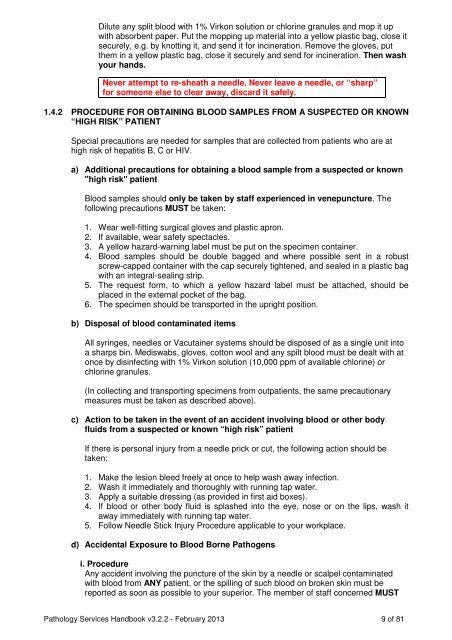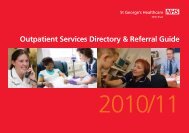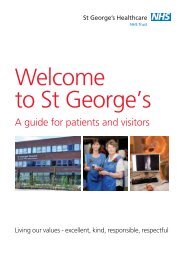pathology services handbook - St George's Healthcare NHS Trust
pathology services handbook - St George's Healthcare NHS Trust
pathology services handbook - St George's Healthcare NHS Trust
You also want an ePaper? Increase the reach of your titles
YUMPU automatically turns print PDFs into web optimized ePapers that Google loves.
Dilute any split blood with 1% Virkon solution or chlorine granules and mop it up<br />
with absorbent paper. Put the mopping up material into a yellow plastic bag, close it<br />
securely, e.g. by knotting it, and send it for incineration. Remove the gloves, put<br />
them in a yellow plastic bag, close it securely and send for incineration. Then wash<br />
your hands.<br />
Never attempt to re-sheath a needle. Never leave a needle, or “sharp”<br />
for someone else to clear away, discard it safely.<br />
1.4.2 PROCEDURE FOR OBTAINING BLOOD SAMPLES FROM A SUSPECTED OR KNOWN<br />
“HIGH RISK” PATIENT<br />
Special precautions are needed for samples that are collected from patients who are at<br />
high risk of hepatitis B, C or HIV.<br />
a) Additional precautions for obtaining a blood sample from a suspected or known<br />
"high risk" patient<br />
Blood samples should only be taken by staff experienced in venepuncture. The<br />
following precautions MUST be taken:<br />
1. Wear well-fitting surgical gloves and plastic apron.<br />
2. If available, wear safety spectacles.<br />
3. A yellow hazard-warning label must be put on the specimen container.<br />
4. Blood samples should be double bagged and where possible sent in a robust<br />
screw-capped container with the cap securely tightened, and sealed in a plastic bag<br />
with an integral-sealing strip.<br />
5. The request form, to which a yellow hazard label must be attached, should be<br />
placed in the external pocket of the bag.<br />
6. The specimen should be transported in the upright position.<br />
b) Disposal of blood contaminated items<br />
All syringes, needles or Vacutainer systems should be disposed of as a single unit into<br />
a sharps bin. Mediswabs, gloves, cotton wool and any spilt blood must be dealt with at<br />
once by disinfecting with 1% Virkon solution (10,000 ppm of available chlorine) or<br />
chlorine granules.<br />
(In collecting and transporting specimens from outpatients, the same precautionary<br />
measures must be taken as described above).<br />
c) Action to be taken in the event of an accident involving blood or other body<br />
fluids from a suspected or known “high risk” patient<br />
If there is personal injury from a needle prick or cut, the following action should be<br />
taken:<br />
1. Make the lesion bleed freely at once to help wash away infection.<br />
2. Wash it immediately and thoroughly with running tap water.<br />
3. Apply a suitable dressing (as provided in first aid boxes).<br />
4. If blood or other body fluid is splashed into the eye, nose or on the lips, wash it<br />
away immediately with running tap water.<br />
5. Follow Needle <strong>St</strong>ick Injury Procedure applicable to your workplace.<br />
d) Accidental Exposure to Blood Borne Pathogens<br />
i. Procedure<br />
Any accident involving the puncture of the skin by a needle or scalpel contaminated<br />
with blood from ANY patient, or the spilling of such blood on broken skin must be<br />
reported as soon as possible to your superior. The member of staff concerned MUST<br />
Pathology Services Handbook v3.2.2 - February 2013 9 of 81





